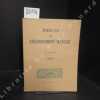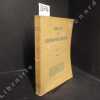-
Century
19th (1)
20th (1)
-
Countries
Denmark (1)
France (1)
"BÉGUYER DE CHANCOURTOIS, (ALEXANDRE-ÈMILE). - THE TELLURIC HELIX - A PERIODIC TABLE FORERUNNER.
Reference : 47239
(1862)
Mémoire sur un classement naturel des corps simples ou radicaux appelé vis tellurique. (7 Avril 1862). (+) Mémoire sur un classement naturel.... addition au Mémoire... du 7 Avril... (+) Sur un classement naturel des corps simples.... addition au Mémoi...
Paris, Mallet-Bachelier, 1862. 4to. No wrappers. In: ""Comptes rendus hebdomadaires des séances de l’Académie des sciences"", Vol. 54, No 13, No 15 a. No 17. Pp. (749- 772, pp. (806-) 868 a. pp. (941-) 992. And vol. 55, No 15. Pp. (583-) 631. (4 entire issues offered). With htitle and titlepage to vol. 54. Titlepage with a stamp in upper corner of titlepage on verso, shown on recto. Béguyer de Chancourtois's papers: pp. 757-761, 840-843, pp. 967-971 and pp. 600-601.
First appearance of Chancourtois's historical paper in which he conceived a way to arrange the chemical elements in a periodic manner, years before Mendelejeff and Lothar Meyer. He arranged the elements on a cylinder in the order of atomic weight. This importent paper was never published in full, but only as abstracts as offered here. His principle of the periodicity of the elements remained unnoticed until the first communication (of April 7) was translated by P.J. Hartog in Nature in 1889 under the title ""A Foreshadowing of the periodic law"".""Generalizing further from Élie’s ideas, Béguyer formulated a method for classifying chemical elements based ""in the last analysis upon the distribution of these elements in the crust of the globe."" His scheme, a precursor of the periodic table, was put forth in ""Vis tellurique, classement des corps simples ou radicaux au moyen d’une système de classification helicoïdal et numérique"" (1862). The model for his theory was the ""telluric screw,"" a helical graph wound about a cylinder. The base of the cylinder was divided by sixteen equally spaced points, and the screw thread was similarly divided on each of its turns"" the seventeenth point was on the second turn directly above the first, the eighteenth above the second, and so forth. Each point was supposed to represent the ""characteristic number"" of some element that could be deduced from its physical properties or chemical characteristics. Actually, Béguyer used unit equivalent weights as characteristic numbers, following Prout, who made hydrogen the unit. These weights were derived by measuring the specific heat of each element in a manner suggested by Regnault."" (DSB).Parkinson ""Breakthroughs"" 1862 C.
Précis de Géomorphologie
1958 Masson & Cie, Editeurs - 1958 - Deuxième édition - Grand in-8, broché sous papier cristal - 395 pages - Nombreuses illustrations et reproductions photographiques en N&B (164 figures, 50 planches hors texte)
Bon état - Menus frottements sur la couverture - Papier cristal légèrement terni - Petit tampon "Bibliothèque J & A. Raynal" en page de titre - Infimes rousseurs en premières et dernières pages - Feuillets partiellement coupés
 Write to the booksellers
Write to the booksellers



